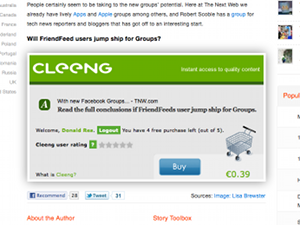
 With online advertising revenues declining, content publishers are looking for alternative ways of profiting from their content. While some have opted for paywalls, charging for all content risks sending the audience to more accessible (free) rivals.
With online advertising revenues declining, content publishers are looking for alternative ways of profiting from their content. While some have opted for paywalls, charging for all content risks sending the audience to more accessible (free) rivals.
Cleeng is a Dutch startup offering a “halfway house” option that could be a little more palatable.
The idea is that publishers can easily opt to make parts of their websites “premium” while making the rest of the site freely accessible. Once set up, the Cleeng plugin lets you define individual parts of a page that you want to charge for. So, an article could be free but the accompanying embedded video could require payment to watch. Even parts of articles can be charged for – the first half a long fictional story could be free, with a charge to finish reading.
Cleeng is currently in private beta, with over 100 bloggers trying the service, which currently takes the form of a WordPress plugin, with a Drupal version in the works. If you’re interested in joining as a tester, you can find more details on the company’s website.
Cleeng has a strong idea here, and it’s easy to see publishers being keen to try it. However, whether users will be any more keen on the “free sample” model than the all-out paywall one remains to be seen. Still, it will be interesting to see how experiments with the plugin turn out. The ability to set time limits means that new content could be chargeable for 24 hours, for example, with other readers being able to come back later to read what they missed without paying.
The startup plans to launch to the public in late January or early February. You can see the Cleeng’s own pitch in the first video below, with a more in-depth look at the WordPress plugin in the second.
Get the TNW newsletter
Get the most important tech news in your inbox each week.
 Cleeng is aiming at encouraging high volume, low-cost payments by allowing publishers to charge between $0.15 and $0.99. Time limits can be set for how long content requires payment, and members of the public can even earn commission for successfully referring paying customers by sharing a special short URL to the page.
Cleeng is aiming at encouraging high volume, low-cost payments by allowing publishers to charge between $0.15 and $0.99. Time limits can be set for how long content requires payment, and members of the public can even earn commission for successfully referring paying customers by sharing a special short URL to the page.




